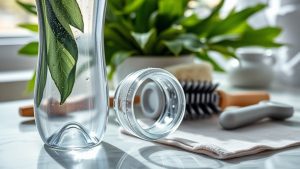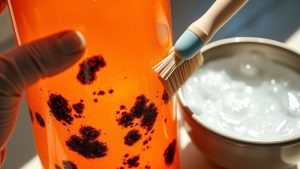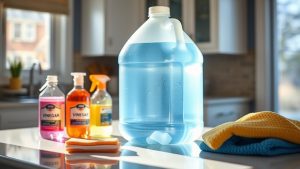
Mold in your water bottle forms due to warmth, moisture, and organic residues like food particles and saliva. When you leave your bottle in a warm spot, temperatures above 60°F encourage rapid growth. Rinsing alone won't help, as biofilms cling to surfaces and require thorough cleaning with brushes and disinfectants. If you don't regularly clean and dry your bottle, you risk creating a health hazard. There's more to uncover about effective prevention strategies.
While you might think your water bottle is a safe haven for hydration, it can actually become a breeding ground for mold under certain conditions. Mold thrives in environments where warmth, moisture, and organic matter are present. If your bottle sits in a warm place, say above 60 degrees Fahrenheit, and you fill it with liquid but don't clean it regularly, you're setting the stage for mold growth. Even small amounts of moisture left in the bottle after a drink can create an ideal breeding ground.
The presence of organic matter, like food particles or saliva, provides a nutrient source for mold spores, allowing them to flourish. Mold spores are microscopic and can easily settle in your water bottle, especially in crevices like the lid or straw. In dark environments, these spores find the perfect conditions to grow, leading to visible signs of mold that can appear fuzzy, slimy, or discolored in hues of green, black, or white. You might notice these signs within just a few days if the conditions remain favorable.
Organic matter like food particles or saliva can nourish mold spores, leading to rapid growth in your water bottle.
One of the main contributors to mold growth in water bottles is insufficient cleaning. If you neglect to clean your bottle regularly, any residual moisture from previous use can boost mold susceptibility. Even if you rinse it out, that mightn't be enough; biofilms, which are complex communities of bacteria and fungi, can cling stubbornly to the surfaces. These biofilms complicate cleaning efforts, as they adhere firmly and often require more than routine rinsing to dislodge. Regularly using brushes and disinfectants becomes essential to guarantee thorough cleaning. Regular cleaning of water bottles is essential to prevent mold growth, as it helps eliminate the moisture and organic matter necessary for mold to thrive.
Another significant factor is the temperature. Higher temperatures hasten mold development, so even if you're using a reusable bottle, storing it in a warm environment might expedite mold growth. Furthermore, if you frequently consume beverages that leave residues, you're inadvertently nurturing mold. Leftover food particles and saliva act like a buffet for spores, promoting growth.
To prevent mold, it's vital to implement simple yet effective preventive measures. Regular cleaning should be a priority, ideally daily or at least frequently. Utilizing hot water can help dissolve organic matter and sanitize the bottle effectively. After cleaning, make sure to dry it thoroughly, paying special attention to crevices that may retain moisture. Employing bleach or specialized sanitizers can further aid in making sure your bottle remains mold-free.
If you're particularly health-conscious, be aware of the potential health implications of mold exposure. For some, it can lead to allergic reactions or respiratory issues, especially in immunocompromised individuals. Foul odors often indicate mold presence and can serve as a precursor to more serious health risks, emphasizing the importance of thorough cleaning and inspection.
Conclusion
In summary, understanding the causes of mold in your water bottle is vital for your health. By keeping it clean, dry, and well-ventilated, you can prevent mold from taking root like an unwelcome guest. Remember, it only takes a bit of moisture and time for mold to thrive, so make it a habit to wash your bottle regularly. With these simple steps, you can guarantee that your hydration stays pure and revitalizing, not a breeding ground for bacteria.



